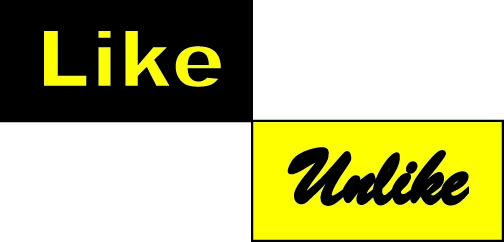Thinking is hard work, and if we had to think our way through every thing we did, we couldn’t keep up. That’s why we use mental shortcuts, which come in two forms: Framing for making sense of things and models that give us strategies for action.
Most of the time, these things work so well that we hardly notice them. We see something new (merchants complain about teenagers loitering near their stores), we frame it (public safety threat) and know what to do (send in the cops to warn the teens and, if that doesn’t work, write tickets). But what if the usual models don’t work or if the thing that pops up doesn’t appear to fit any previous frames? That’s when it’s time for something I call “Like/Unlike.”
To understand why this is helpful, you have to know how the shortcuts work together. The key step is the framing, which is a fancy way of saying we’ve put something into a category (teens loitering = public safety threat). The point of putting things into categories is to limit our options for response. There’s nothing wrong with that—it gives us a manageable list of actions to take—and as long as we put things in the right categories, these actions should work. Mind the caution: As long as we put things in the right categories.
If you look around, you can see this framing process at work in cities. One of my favorites is the dilemma posed by food trucks for city regulators and health inspectors. Are food trucks more like restaurants or hot dog carts? If you put them in the hot dog cart frame, then you should regulate where they operate but not worry too much about health inspections. If you put them in the restaurant frame, then you shouldn’t say much about where they operate but you should be diligent about health inspections. (My suggestion: Consider them a third category with their own set of regulations.)
The key is to pause before applying the frame. And Like/Unlike will help with that. It’s a simple way of checking your assumptions. You can do it through a quick mental checklist or you can pull together a group and do it more formally.
Either way, it involves listing attributes and categories, then asking whether the attributes fall into any of the categories. In the food truck example, food trucks are like hot dog carts in that they do business on public rights of way (which raises concerns about location) but like restaurants in that they prepare food in non-standard ways (which raises concerns about public health).
If you have enough attributes and categories, you can make a grid and do check marks. When you’ve finished, you should be able to stand back and see if the evidence points toward an obvious category (and resulting set of actions) or if you should approach the problem as something entirely new. (Don’t be too surprised if you find that you need more information. After all, why are those teenagers standing on that corner?)
Again, the key is the pause. The best leaders are those who are thoughtful, who don’t rush to judgment, who see dimensions to problems that others don’t. The thoughtfulness doesn’t paralyze good leaders. They understand full well the need for action, but they want to be sure the analysis that drives the actions is as accurate as possible.
And what makes it accurate is putting things in the right categories from the start. Like/Unlike will help.
This is part of a series of brief postings called Rules for Reformers. For an introduction to the series, please click here.

